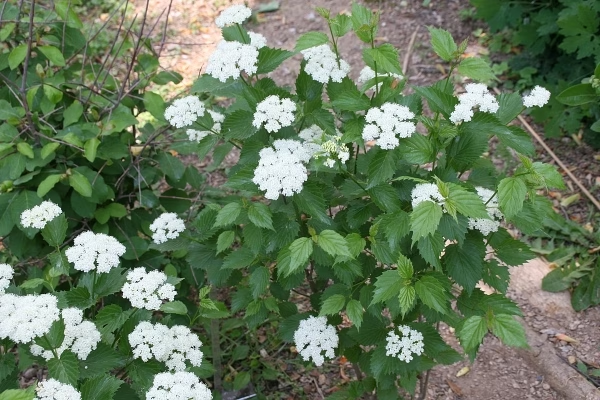
Arrowwood Viburnum
Botanical Name
:
Viburnum dentatum
Plant Type
:
Deciduous shrub
Seasons
:
Plant in fall or early spring; blooms in spring
Sun Level
:
Full sun to partial shade (best flowering in full sun)
Ideal Soil Temperature for Planting
:
60–75°F (16–24°C)
Soil Type
:
Moist, well-drained soil; adaptable to clay, loam, and sandy soils
Hardiness Zones
:
USDA Zones 3–8
Germination
:
Seeds require cold stratification for 60–90 days before planting
P.H. Level
:
Slightly acidic to neutral (5.5–7.0)
Water/Irrigation
:
Moderate water needs; drought-tolerant once established
Fertilization
:
Low maintenance; can use a balanced fertilizer in early spring if needed
Habit
:
Rounded, multi-stemmed shrub with dense branching
Propagation
:
Softwood cuttings in summer or through seed with stratification
Final Plant Height
:
6–10 ft
Spread
:
6–12 ft
Flowers
:
Small, creamy-white clusters (corymbs) in late spring to early summer
Attracts
:
Pollinators (bees, butterflies), birds (feed on berries)
Uses
:
Ornamental landscaping, hedges, wildlife habitat, privacy screens, foundation plantings, native gardens, wildlife gardens
Companions
:
Black-eyed Susan, Purple Coneflower, Serviceberry, Red-twig Dogwood
Pruning
:
Prune after flowering to maintain shape and remove dead/damaged branches
Toxicity
:
Non-toxic to humans and pets
Pests
:
Viburnum leaf beetle, aphids, scale insects
Diseases
:
Powdery mildew, leaf spot, root rot (in poorly drained soils)
Fun Fact
:
Native Americans used the straight stems of Arrowwood Viburnum to make arrow shafts, hence the name “Arrowwood.”
Botanical Name
:
Viburnum dentatum
Plant Type
:
Deciduous shrub
Seasons
:
Plant in fall or early spring; blooms in spring
Sun Level
:
Full sun to partial shade (best flowering in full sun)
Ideal Soil Temperature for Planting
:
60–75°F (16–24°C)
Soil Type
:
Moist, well-drained soil; adaptable to clay, loam, and sandy soils
Hardiness Zones
:
USDA Zones 3–8
Germination
:
Seeds require cold stratification for 60–90 days before planting
P.H. Level
:
Slightly acidic to neutral (5.5–7.0)
Water/Irrigation
:
Moderate water needs; drought-tolerant once established
Fertilization
:
Low maintenance; can use a balanced fertilizer in early spring if needed
Habit
:
Rounded, multi-stemmed shrub with dense branching
Propagation
:
Softwood cuttings in summer or through seed with stratification
Final Plant Height
:
6–10 ft
Spread
:
6–12 ft
Flowers
:
Small, creamy-white clusters (corymbs) in late spring to early summer
Attracts
:
Pollinators (bees, butterflies), birds (feed on berries)
Uses
:
Ornamental landscaping, hedges, wildlife habitat, privacy screens, foundation plantings, native gardens, wildlife gardens
Companions
:
Black-eyed Susan, Purple Coneflower, Serviceberry, Red-twig Dogwood
Pruning
:
Prune after flowering to maintain shape and remove dead/damaged branches
Toxicity
:
Non-toxic to humans and pets
Pests
:
Viburnum leaf beetle, aphids, scale insects
Diseases
:
Powdery mildew, leaf spot, root rot (in poorly drained soils)
Fun Fact
:
Native Americans used the straight stems of Arrowwood Viburnum to make arrow shafts, hence the name “Arrowwood.”
Written by Nondiah Khalayi – https://www.linkedin.com/in/nondiah-khalayi/

